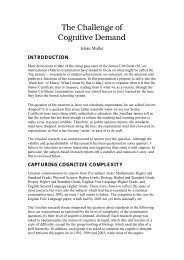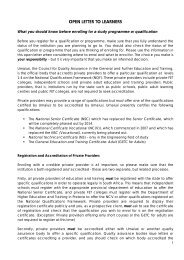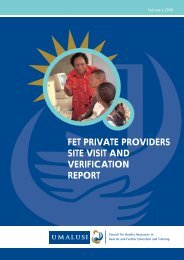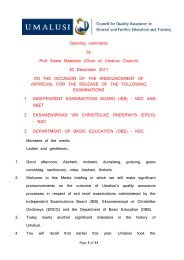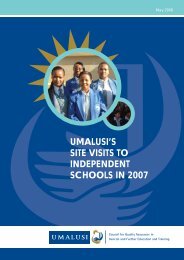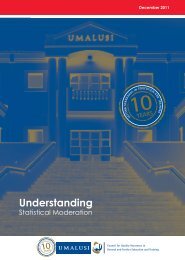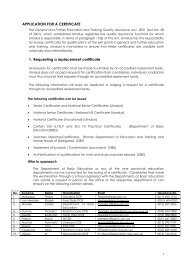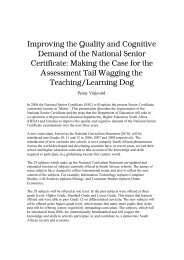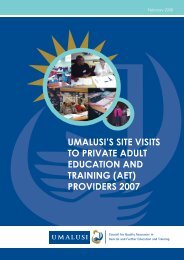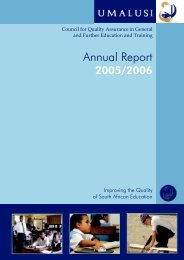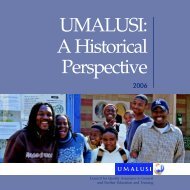Inspecting the Foundations - Umalusi
Inspecting the Foundations - Umalusi
Inspecting the Foundations - Umalusi
You also want an ePaper? Increase the reach of your titles
YUMPU automatically turns print PDFs into web optimized ePapers that Google loves.
4.2.1.5 Private ABET provider documentationWhen nine of <strong>the</strong> selected large independent providers under <strong>the</strong> authority of <strong>the</strong> IEB wereinterviewed, it emerged that between <strong>the</strong>m <strong>the</strong>re was a variety of curriculum offerings, from<strong>the</strong> full range of learning programmes required for a GETC: ABET, to single learning areas. Someprivate providers, for example, offer just English and Ma<strong>the</strong>matics in customized forms; o<strong>the</strong>rs offereight learning areas as well as various short courses. The curriculum development processes anddocuments are diverse (brief descriptions of <strong>the</strong> courses offered by <strong>the</strong> nine providers are availableat www.umalusi.org.za/<strong>Inspecting</strong><strong>the</strong><strong>Foundations</strong>/Appendix 4). Private providers have a range ofcurriculum documents – from course outlines to sets of teaching and learning materials for which<strong>the</strong>re appear to be no separate curriculum documents. All of <strong>the</strong>se providers use, and mentioned,<strong>the</strong> SAQA unit standards. Interestingly, none mentioned <strong>the</strong> IEB User Guides (2006, 2007, 2008 and 2009).Material submitted for review by private providers can be categorized in two ways. One type ofmaterial comprises process documents: <strong>the</strong>se materials include items such as steps of curriculumdevelopment processes; <strong>the</strong> format workbooks should take; possible interests of learners that shouldbe taken into account (for example, ‘buying a car’, ‘consumer rights’, ‘loan sharks’, and o<strong>the</strong>rs);target audiences; things to bear in mind when selecting ‘learning units’; and detailed notes on howto interpret <strong>the</strong> unit standards. Such information was given by providers who customize curricula forindividual clients, and have no generic learning programme documents.The second type of material comprises curriculum documents in outline or learning material (textbook)form. In all fi ve instances in which curriculum documents were provided, coherence isprovided via <strong>the</strong> <strong>the</strong>matic design of <strong>the</strong> courses – specifi c outcomes and assessment criteria areclustered <strong>the</strong>matically. The specifi c outcomes and assessment criteria are provided ei<strong>the</strong>r toge<strong>the</strong>rwith subject-matter to be covered, texts to be used, and <strong>the</strong> scope of <strong>the</strong> content; or in separatesections. For instance, in some examples criteria are followed immediately by <strong>the</strong> associatedcontent. In o<strong>the</strong>r examples, all specifi c outcomes are listed at <strong>the</strong> start, and <strong>the</strong> content modulesfollow. The relationship between outcomes and content is clearer in examples where <strong>the</strong> outcomesare followed immediately by <strong>the</strong> associated content.The degree to which content was specifi ed differed between providers, as did <strong>the</strong> amount ofcontent, and <strong>the</strong> degree to which content was grouped into conceptual categories.4.2.2 CURRICULA FOR SETA LEVEL 1 QUALIFICATIONSIt seems that none of <strong>the</strong> Seta qualifi cations have prescribed intended curricula attached at apolicy level. The intended curriculum is presupposed to be lodged within <strong>the</strong> unit standards, and<strong>the</strong> assumption is that any provider can <strong>the</strong>n design a course based on <strong>the</strong> unit standards, teach<strong>the</strong> course, and/or assess it, as long as <strong>the</strong> following is in place:• The provider is accredited by a quality assurance body;• The course is approved as one likely to lead to <strong>the</strong> specifi ed learning outcomes; and• The assessment gets moderated and verifi ed against <strong>the</strong> learning outcomes by a qualityassurance body (<strong>Umalusi</strong> 2007b).Thus, <strong>the</strong>re are in <strong>the</strong>ory as many curricula as <strong>the</strong>re are providers, and each provider will have itsown interpretation of <strong>the</strong> unit standards and qualifi cation requirements. <strong>Umalusi</strong> was unable toobtain any of <strong>the</strong> actual learning programmes offered by providers for <strong>the</strong> present research, as<strong>the</strong>y are regarded as trade secrets. Never<strong>the</strong>less, earlier <strong>Umalusi</strong> fi ndings (<strong>Umalusi</strong> 2007b) on <strong>the</strong>fundamental programmes (on NQF Levels 1-4) offered by providers revealed that <strong>the</strong> programmesevaluated <strong>the</strong>n appeared highly variable, were often characterized by discrete activities whichprecluded <strong>the</strong> progressive building up of skills, and some were inclined to teach informationabout a skill or ability ra<strong>the</strong>r than providing opportunities to acquire such skills or develop thoseabilities. It was also diffi cult to evaluate <strong>the</strong> standard of <strong>the</strong> learning from <strong>the</strong> materials submittedfor evaluation, and <strong>the</strong> research indicated that many of <strong>the</strong> assessment tasks in <strong>the</strong> materials31



